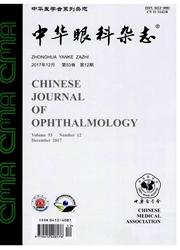

 中文摘要:
中文摘要:
目的探讨采用高能量紫外光照射的角膜胶原交联术(CXL)治疗进展期圆锥角膜的安全性及治疗效果。方法收集在2011年7月至2012年7月于厦门大学附属厦门眼科中心接受住院治疗的34例(37只眼)进展期圆锥角膜患者的临床资料,进行回顾性病例对照研究。将全部患者分为两组,即传统CXL组(A组)和高能量CXL组(B组)。A组患者共16例(17只眼)。采用标准的紫外光进行照射.照射能量为3.0mW/cm^2.照射时间为30min。B组患者共18例(20只眼)。采用高能量的紫外光照射进行照射,照射能量为9.0mW/cm^2,照射时间为10min。两组患者的手术操作及围手术期处理均相同。术前与术后分别对两组患者行裸眼视力、最佳矫正视力、角膜地形图、角膜内皮细胞计数、眼前节光学相干断层扫描及角膜共聚焦显微镜等检查,并记录两组患者的主观不适症状评分。两组患者在不同时间点的主观不适症状评分、角膜地形图参数及角膜内皮细胞计数的描述均采用均数±标准差(x±s)表示。比较采用两因素重复测量方差分析。结果B组患者术中及术后出现主观不适症状的程度明显小于A组患者,差异有统计学意义(F=2.96,P〈0.05)。随着术后时间的延长,两组患者的不适症状均有所减轻,B组患者术后不适症状持续时间较A组短,差异有统计学意义(F=4.52,P〈0.05)。两组患者术后1d与术中的主观不适症状比较无改善,差异无统计学意义[A组为(t=0.52,P〉0.05),B组为(t=0.67,P〉0.05)1。术后3d,两组患者的主观不适症状开始减轻。将两组患者术后3d、l周及1个月的主观不适症状与术中进行比较,差异有统计学意义[A组为(t=2.54,3.87,4.12;P〈0.05),B组为(t=2.23,3.41,3.67;P〈0.05)]。患者术后1周的主观不适症状较术后3d明显减轻。将两组患?
 英文摘要:
英文摘要:
Dbjective To evaluate the safety and long-term efficiency of corneal collagen cross-linking (CXL) with high-intensity ultraviolet radiation in the treatment of progressive keratoeonus. Methods The clinical data of 34 cases (37 eyes) with progressive keratoconus who have been hospitalized in Xiamen Eye Center of Xiamen University were collected from July 2011 to July 2012 for our retrospective case-control study. Patients were separated into 2 groups: traditional CXL group (Group A) and high-intensity group (Group B ). There were 16 cases (17 eyes ) in Group A. All the patients were treated with standard ultraviolet radiation. The irradiation energy was 3 mW/cm^2, and the irradiation time was 30 min. There were 18 cases (20 eyes) in Group B. All the patients were treated with high-intensity ultraviolet radiation. The irradiation energy was 3 mW/cm^2, and the irradiation time was 30 min. Surgical operation and perioperative treatment are the same in patients of two groups. Before and after the operation, naked eye visual acuity, best corrected visual acuity, corneal topography, corneal endothelial cell count, anterior segment optical coherence tomography and corneal confocal microscopy were inspected for patients in two groups. And the subjective discomfort scores of two groups were recorded. Two groups of patients were followed up for 3 years. The symptom scores of two groups in different time, corneal topography parameters and corneal endothelial cell count were presented as mean _+ standard deviation (:~_+s)and compared by two factor repeated measures analysis of variance. Results The degree of subjective discomfort of patients in Group B was significantly lower than that in Group A, the difference was statistically significant (F= 2.96, P〈0.05 ). As time went on, subjective discomfort of patients in two groups was reduced. The duration of postoperative discomfort in Group B was less than that in Group A, and the difference was statistically significant ( F = 4.52
 同期刊论文项目
同期刊论文项目
 同项目期刊论文
同项目期刊论文
 期刊信息
期刊信息
